7bf71a84e81892a5e202d29c8d0a28bd.ppt
- Количество слайдов: 143

raghavan-gilbert/vw-99 1

Gender and Reproductive Behaviour p Understanding gender provides: w insights into men’s and women’s behaviour w relationships and w reproductive decisions w These insights are crucial to communicating with and serving both men and women effectively. raghavan-gilbert/vw-99 2

Gender and Reproductive Behaviour Z “Gender” refers to the different roles that men and women play in society Z Also to the rights and responsibilities that come with these roles Z “Gender” differs from “sex”, which refers to the biological and physical differences between men and women raghavan-gilbert/vw-99 3

Gender and Reproductive Behaviour p Gender roles usually taken for granted reflected in: u u u u family structures household responsibilities labour markets schools health care systems laws public policies The influence of gender is similar in strength to religion, race, social status and wealth raghavan-gilbert/vw-99 4

Gender and Reproductive Behaviour p Gender roles begin at birth and span a lifetime: very young boys and girls learn from their families and peers how they are expected to act u around people of the same sex u around people of the opposite sex raghavan-gilbert/vw-99 5

Fr om d hoo s e Adu lt ng en c e te La nc ce You Ea Ad rly ol es c les raghavan-gilbert/vw-99 in pee r infl uen ce o Ad ood th dul A B Puberty l Schoo es fluenc re er pe ssu pre e ur nd ss l a re ra l p tu a ul iet C oc s M Pre Puberty fa in mil flu y en ce Community approval & Support Soc io cultu influ ral ence MB TO To & ily ity Fam mun m Co Fa m su ily pp ort O In Utero technica l advance s t es ld O ld yrs 5 O Near Old rs) 55 -64 y ( >7 Yo Ol ung (65 d -74 yr s) W The Life Cycle In RH 6

GENDER PERSPECTIVES IN RH: A LIFE CYCLE MODEL In Utero ESex selection E - abortion - infanticide Value of the girlchild GBiological vulnerability raghavan-gilbert/vw-99 7

GENDER PERSPECTIVES IN RH: A LIFE CYCLE MODEL Pre-Puberty EConditioning to gender roles - nutrition - education - abuse - violence - work allocation Child Pornography Child Prostitution E E raghavan-gilbert/vw-99 GConditioning to gender roles - nutrition - education - work allocation - domestic violence - abuse 8

GENDER PERSPECTIVES IN RH: A LIFE CYCLE MODEL Puberty EMenarche EVirginity EFGM EPregnancy EViolence raghavan-gilbert/vw-99 GRites of passage GGender Role conditioning GAbuse 9

GENDER PERSPECTIVES IN RH: A LIFE CYCLE MODEL Early Teens EHormonal Changes. GGender role imprinting ECuriosity Gpeer influence EViolence Gabuse EExploitation EPregnancy raghavan-gilbert/vw-99 10

GENDER PERSPECTIVES IN RH: A LIFE CYCLE MODEL Late Teens ESexual Bonding GGender roles acted out EPregnancy GSexual activity ESTD/HIV EGender roles enacted. GHigh risk EHigh risk behaviour EViolence and Abuse GAbuse raghavan-gilbert/vw-99 11

Young Adulthood EGender Roles internalized (or GGender roles questioned) internalized Eproductive role (non NSA/NSA) Gproductive role Ereproductive role Gsexual role - household - child minding - contraception - pregnancy/abortion - sexual - nurturing & care giving raghavan-gilbert/vw-99 12

GENDER PERSPECTIVES IN RH: A LIFE CYCLE MODEL Adulthood Gender role entrenched - low economic power - community respect important - low legal power - domestic violence - STD/AIDS - health risks * malnutrition * maternal depletion syndrome * gynaecological morbidity, * cancer cervix and breast risks * high risk abortion and sequelae - uneven access to RH services - Use of FP services E raghavan-gilbert/vw-99 G Gender roles entrenched - productive - decision makers - little involvement in contraception - domestic violence - marital infidelity - little household/ care giving roles 13

GENDER PERSPECTIVES IN RH: A LIFE CYCLE MODEL Near Old (55 -64) EGender roles still entrenched Emenopause - osteoporosis c. v. risks body image depression loneliness care giving gynae. cancers lifestyle diseases DM. HPT, CVD, cancers raghavan-gilbert/vw-99 GGender roles still entrenched but weakening loss of sexual drive less economic power loss of health greater dependence on caregiving of wife/females risk of infidelity depression G G G 14

GENDER PERSPECTIVES IN RH: A LIFE CYCLE MODEL Old Age (65 -74) EWidowed or in care giving role - social alienation - poverty - failing health raghavan-gilbert/vw-99 GWeakening or reversal of gender roles - dependence on women for care-due to disability - lifestyle diseases - cancers - mental health 15

GENDER PERSPECTIVES IN RH: A LIFE CYCLE MODEL Oldest Old (75 years) GReversal of gender EMental health roles EEconomic dependency GDependence of ECancers female care givers EPhysical disability GMental health GCancers GPhysical disability raghavan-gilbert/vw-99 16

Gender and Reproductive Behaviour u u adolescent males experience more sexual freedom than adolescent females Potentially harmful sexual attitudes and behaviour that can develop during youth are often difficult to change during adulthood. raghavan-gilbert/vw-99 17

Gender and Reproductive Behaviour p Traditional male and female gender roles: w deter couples from discussing sexual matters w condone risky sexual behaviour w ultimately contribute to poor reproductive health among both men and women raghavan-gilbert/vw-99 18

Gender and Reproductive Behaviour p Programmes can encourage men to adopt positive gender roles and be: Y supportive husbands, and Y caring fathers raghavan-gilbert/vw-99 19

Gender and Reproductive Behaviour Health care providers, policymakers, and donors recognize: v the direct connection between men and women’s gender roles v their reproductive health v the effect that inequities in gender roles have on women’s well being raghavan-gilbert/vw-99 20

Understanding Gender w gender roles and gender norms are culturally specific and thus vary tremendously around the world. w however, men and women differ substantially from each other in power, status and freedom. w men have more power than women in all societies raghavan-gilbert/vw-99 21

Understanding Gender o “Power” is a broad concept that describes the ability or freedom of individuals to make decisions and behave as they choose a person’s access to resources and ability to control them. raghavan-gilbert/vw-99 22

Understanding Gender Two types of power help to describe the inequities in male and female gender roles - “power to” and “power over” k “Power to” describes the ability of individuals to control their own lives and to use resources for their own benefit k “Power over” means that individuals can assert their wishes, even in the face of opposition, and force others to act in ways that they may not want to raghavan-gilbert/vw-99 23

Understanding Gender F Calls for changes in gender roles, and hence F F F behaviour, often touch emotional and political nerves such change is perceived as threatening is part of the global trend toward equality and justice studying how gender affects reproductive behaviour is necessary for improving reproductive health for all raghavan-gilbert/vw-99 24

Understanding Gender p Differences in power between men and women are not absolute or universal. Some poor, illiterate, unemployed, or homosexual men have little power and few resources p Women’s gender roles do give them some power but is more limited and influenced by: w her culture w age w income and education raghavan-gilbert/vw-99 25

Understanding Gender j Type of marriage j A woman’s power to make decisions increases with her level of education also with her husband’s level of education j younger women who marry older men have less power gender roles are changing toward more equality for younger men and women in some cultures raghavan-gilbert/vw-99 26

How Gender Roles Affect Reproductive Behaviour z Gender has a powerful influence on reproductive decision-making and behaviour z men are the primary decision-makers about sexual activity, fertility, and contraceptive use raghavan-gilbert/vw-99 27

How Gender Roles Affect Reproductive Behaviour p Men are often called “gatekeepers” and have many power roles • husbands • fathers • uncles • religious leaders • doctors • policy-makers and • local and national leaders raghavan-gilbert/vw-99 28

How Gender Roles Affect Reproductive Behaviour Little is known about how gender roles affect these decisions to: w w w practice family planning choose when and how to have sexual relations engage in extramarital sexual relations use condoms to prevent STDs breastfeed seek prenatal care raghavan-gilbert/vw-99 29

How Gender Roles Affect Reproductive Behaviour Gender is just one of many other factors such as: w w w w p Education level family pressures social expectations socio-economic status exposure to mass media personal experience expectations for the future religion Consequently, no two couples’ “decision-making environments” are identical raghavan-gilbert/vw-99 30

Gender Roles Can Harm Reproductive Health Traditional gender roles can jeopardize the reproductive health of both women and men. w Inequities in power make women more vulnerable to men’s risky sexual behaviour and irresponsible decisions. w Gender roles can be unhealthy for men too raghavan-gilbert/vw-99 31

Gender Roles Can Harm Reproductive Health q Women have difficulty communicating about sex or RH, because of their gender roles q Women may submit to men because they are afraid of retaliation. q Male gender roles can contribute to men contracting and transmitting STDs raghavan-gilbert/vw-99 32

Gender Roles Can Harm Reproductive Health b b • • Male gender roles harm men’s health as well as women’s. Men’s control over reproductive decisionmaking may be weakening traditional gender roles are starting to change with social opportunities for women power is being redistributed raghavan-gilbert/vw-99 33

Improving Reproductive Health D Couple, or spousal, communication can be a crucial step toward increasing men’s participation in reproductive health D Communication enables husbands and wives to know each other’s attitudes toward family planning and contraceptive use D Communication also can encourage shared decision-making and more equitable gender roles raghavan-gilbert/vw-99 34

Obstacles to Couple Communication s Research suggests that a complex web of social and cultural factors impede such discussions s In many societies sex is a taboo subject for men and women to discuss s Afraid of rejection by a sex partner s Women’s inferior status and lack of power limit couple communication raghavan-gilbert/vw-99 35

Obstacles to Couple Communication n Women’s status and communication. n Wide gap in education between the couple n Low Educational level of the couple raghavan-gilbert/vw-99 36

Obstacles to Couple Communication i Better-educated women can communicate more easily with their husbands. i Education may also increase a woman’s earning capacity - and thus her leverage in house-hold decision making. i A woman who has some economic power more likely to discuss family planning with her husband. raghavan-gilbert/vw-99 37

Obstacles to Couple Communication k. The type of marriage - whether free choice, arranged, or polygymous - also affects the relative power of a woman k. The age of a woman at first marriage relates to her ability to communicate raghavan-gilbert/vw-99 38

Gender and Risk m Being ‘male’ or being ‘female’ has a major effect on an individual’s health and wellbeing m Combination of their biological sex, the gendered nature of cultural, economic and social lives put individuals at risk of developing some health problems while protecting them from others raghavan-gilbert/vw-99 39

Gender and Risk X The subsequent effect of these health problems on the individuals will also be influenced by their gender roles and their sex X The ‘natural’ course of a disease may be different in women and men X women and men themselves often respond differently to illness raghavan-gilbert/vw-99 40

Gender and Risk ksociety responds differently to sick males and sick females kwomen and men: • may respond differently to treatment • may have different access to health care • be treated differently by health providers. raghavan-gilbert/vw-99 41

Gender and Risk p Infectious Diseases Differences are a function of the interaction between biological factors and gender roles and relations w Biological factors vary between the sexes and influence susceptibility and immunity to diseases raghavan-gilbert/vw-99 42

Gender and Risk w Gender roles and relations influence: • the degree of exposure to the relevant vectors w The access and control of the resources needed to protect women and men raghavan-gilbert/vw-99 43

Gender and Risk w Differences between female and male prevalence and incidence rates are difficult to measure since cases in women are more likely to be undetected. raghavan-gilbert/vw-99 44

Gender and Risk Even when diseases are shared by both sexes, they may have: n different manifestations histories in women and men or natural n differences in the severity of their consequences raghavan-gilbert/vw-99 45

Gender and Risk For example, malaria: Z biologically, women’s immunity is compromised during pregnancy making them more likely to become infected during this period Z implies differential severity of the consequences during her lifetime raghavan-gilbert/vw-99 46

Gender and Risk r Malaria during pregnancy is an important cause of maternal mortality, spontaneous abortion and stillbirths r Particularly during pregnancy, malaria contributes significantly to the development of chronic anemia Biological differences between the sexes can produce different health outcomes among women and men when exposed to the same environmental hazard. raghavan-gilbert/vw-99 47

Gender and Risk p How and where women and men carry out their daily activities will expose women and men to disease differentially: kwomen in seclusion kwomen’s more extensive clothing kdomestic labour kwater-related domestic work raghavan-gilbert/vw-99 48

Gender and Risk p Tuberculosis (TB) w Official figures show that twice as many male cases of TB as female cases w At young ages, the prevalence of infection in boys and girls is similar, but a higher prevalence has been found in men of older ages raghavan-gilbert/vw-99 49

Gender and Risk b propensity to develop disease after infection with Mycobacterium tuberculosis may be greater among women of reproductive age than among men of the same age. raghavan-gilbert/vw-99 50

Gender and Risk k Care of dependants may also increase women’s risk of contracting particular diseases k Considerable evidence exists that indicate women are hampered in their use of health services by: • lack of transport raghavan-gilbert/vw-99 51

Gender and Risk p inadequate resources p their husband’s refusal to grant permission p reluctance to expose themselves to health care providers p Gender differences in illness behaviour and in societal responses to female and male patients often cause women to come later for care raghavan-gilbert/vw-99 52

Gender and Risk p HIV/AIDS and Other Sexually Diseases u sexually transmitted diseases (STDs) continue to be a major cause of distress, disability and sometimes death of both sexes u HIV/AIDS in particular, is continuing to spread, killing millions of women and men in the prime of their lives raghavan-gilbert/vw-99 53

Gender and Risk Z AIDS is becoming an increasingly female Z • • affair Heterosexual transmission is now dominant in most parts of the world Of the estimated 5. 8 million HIV infections that occurred in 1997, nearly half were in women Women now account 42% of the people living with HIV raghavan-gilbert/vw-99 54

Gender and Risk This increase in the number of HIV positive women reflects: z their greater biological vulnerability to the disease z a consequence of the social constructions of female and male sexuality z profound inequalities that characterise many heterosexual relationships raghavan-gilbert/vw-99 55

Gender and Risk n Biologically, the risk of HIV infection during • • unprotected vaginal intercourse is two to four times higher for women than men. women have a bigger surface area of mucosa exposed to their partner’s sexual secretions during intercourse Semen also contains a higher concentration of HIV than vaginal secretions raghavan-gilbert/vw-99 56

Gender and Risk p semen can stay in the vagina for hours after p p intercourse co-existing STDs, increase the risk of HIV infection by three to four times (and in some cases five to six times) women are biologically more vulnerable 50 -80% of STDs in women have no symptoms or have symptoms that cannot easily be recognised are too ashamed to visit a doctor raghavan-gilbert/vw-99 57

Gender and Risk Z This biological vulnerability is too often reinforced by socially constructed constraints on women’s ability to protect themselves Z Heterosexual encounters are socially shaped with certain modes of behaviour seen as appropriate for each sex raghavan-gilbert/vw-99 58

Gender and Risk w w men be the initiators be perceived powerful be seen as risk-takers (‘not afraid’) Many women find the heterosexual relationship a difficult one in which to negotiate a strategy for their own safety. raghavan-gilbert/vw-99 59

Gender and Risk In many societies sex continues to be defined primarily in terms of male desire with women perceived as passive recipients _ women may find it difficult to express their own needs _ find it difficult to assert their wish for safer sex _ find it difficult to negotiate for their partner’s fidelity or no sex raghavan-gilbert/vw-99 60

Gender and Risk For many women, their economic and social security is dependent on the support of a male partner m fear of abandonment can be a powerful force m discrimination against divorced or separated women and their children raghavan-gilbert/vw-99 61

Gender and Risk p p no legal right to refuse conjugal sex the threat of physical violence or abuse many women will prefer to risk unsafe sex in the face of more immediate threats to the well-being of themselves and their children raghavan-gilbert/vw-99 62

Gender and Risk i If a woman does become infected with HIV or with any other STD, gender inequalities may affect the progression of the illness and possibly her survival chances. i The exclusion of women from many research studies on HIV/AIDS has had the additional effect of prolonging the male bias in research. raghavan-gilbert/vw-99 63

Gender and Risk q The combination of unequal access to care and the gender gap in medical knowledge contributes to a situation where women in both rich and poor countries have a shorter life expectancy than men after a diagnosis of AIDS raghavan-gilbert/vw-99 64

Gender and Risk p Violence and Injuries Intentional and non-intentional injuries are among the major causes of morbidity and mortality for both women and men at all ages and across all societies. men are more likely than women: y to die in car accidents yto suffer death or disability as a result of occupational hazards. raghavan-gilbert/vw-99 65

Gender and Risk W Although women have lower rates of unintentional injuries overall, they are more likely than men to suffer injuries at home because of their domestic responsibilities. Intentional injuries: W more common among men W directly connected to ‘masculine’ behaviour, risk-taking, aggression and the consumption of drugs and alcohol. raghavan-gilbert/vw-99 66

Gender and Risk Health consequences of gender-based violence Non-fatal Outcomes Physical health consequences p p p STDs Injury Unwanted pregnancy Miscarriage Chronic pelvic pain raghavan-gilbert/vw-99 67

p p p Headaches Gynaecological problems Alcohol/drug abuse Asthma Irritable bowel syndrome Injurious health behaviours (smoking, unprotected sex) raghavan-gilbert/vw-99 68

Mental health consequences n Post-traumatic stress disorder n Depression n Anxiety n Sexual dysfunction n Eating disorders n Multiple personality disorder n Obsessive-compulsive disorder raghavan-gilbert/vw-99 69

Fatal Outcomes r r r HIV/AIDS Suicide Homicide raghavan-gilbert/vw-99 70

FRAMEWORKS FOR STUDYING VIOLENCE AGAINST WOMEN (VAW) 1. 2. 3. 4. 5. PSYCHOPATHOLOGICAL MODEL SOCIOLOGICAL EXPLANATIONS NESTED FRAMEWORK CRITICAL PATH APPROACH THE PATRIARCHY FRAMEWORK raghavan-gilbert/vw-99 71

1. PSYCHOPATHOLOGICAL MODEL p Due to pathological/psychopathological disorder – conjugal paranoia – delusions of sexual spousal infidelity – intermittent explosive disorders (temporal lobe epilepsy, post episode amnesia – borderline personality disorder Issue: Since person is perceived to be sick, he is then absolved from the wrong doing raghavan-gilbert/vw-99 72

p Using violence as beneficial to the maintenance of family structure The process of socialisation especially of males • Men socialised into aggression for problem solving and demonstrating authority • Women socialised to submit to male authority • Encouraged to develop character traits that complement male headship of the family Sociological perspectives on deviance i. e. • abusive individuals are deviants brought about by an unfulfilled childhood, lack of attention, exposure to raghavan-gilbert/vw-99 violence etc. 73

NESTED FRAMEWORK INTERACTIONIST EXPLANATION A) B) C) D) Personal Microsystem Exosystem Macrosystem raghavan-gilbert/vw-99 74

p Interactionist Explanation Personal Individual’s developmental experiences shapes his response • domestic violence experience • physical abuse (especially in women) • sexual abuse raghavan-gilbert/vw-99 75

PROGRAMME INTERVENTIONS 1. Self Help Groups w Self esteem w Personal empowerment 2. Programmes for aggressors raghavan-gilbert/vw-99 76

p Interactionist Explanation Microsystem interpersonal/family structure • male dominance in family • male control of wealth • marital conflict; power relationships, patterns of communication • use of alcohol raghavan-gilbert/vw-99 77

Interactionist Explanation Exosystem institutional social structure for dealing with stressful events p unemployment p low socio-economic status p (physical) isolation of woman p delinquent peers p lack of welfare service support raghavan-gilbert/vw-99 78

PROGRAMME INTERVENTIONS p Strengthen Health System Improvement of information system • to identify • to assist and • to refer on gender-based abuse raghavan-gilbert/vw-99 79

p Interactionist Explanation Macrosystem broad sets of cultural beliefs and values • “masculinity” linked to dominance/honor • rigid gender roles • male “ownership” of women • approval of physical chastisement of women • “machismo” (cultural ethos that condones violence as a means of settling of raghavan-gilbert/vw-99 80 disputes)

p Legal Reform (paradox of reporting) – analysis of laws – strengthen legal reform – provide safe alternative Disseminate results • include and use mass media raghavan-gilbert/vw-99 81

4. CRITICAL PATH APPROACH p Traces path that battered women take in finding a response to a problem of violence against women (VAW) – Violence - Physical, sexual and psychological – Damages self esteem, identity, and development of the woman • to gain information about the paths taken to seek care and solutions • to learn from women themselves what their perceptions of the response they received as they searched for help • to gain insights into the preconceptions and responses of service providers in relation to violence against women • to formulate interventions, together with the community actors, that identify the obstacles identified in the study and strengthen a coordinated response raghavan-gilbert/vw-99 82

5. THE PATRIARCHY FRAMEWORK p Examines the entire fabric of society – Patriarchy is defined as a set of beliefs and values which “lays down the supposedly proper relations” between men and women, between women and women, and between men and men – Looks beyond the individual, family and interpersonal relations – Shows how cultural values, social institutions and mechanisms to legitimize and maintain: • male power over women • male use of power inside and outside the home • men’s work is of more value, more significance, more pay • male violence upon women comes from the exercise of male power • male desire to maintain that power raghavan-gilbert/vw-99 83

REPRODUCTIVE HEALTH CONSEQUENCES -Implications for Clinical Practiceu There are still large gaps in the education and training of health care u u u providers The problems of violence can not be fully dealt with in the medical setting Spousal violence is considered one of the most important causes of injuries among women, more important than car accidents, for instance Violence may be a more common problem for pregnant women than preeclampsia, gestational diabetes and placenta previa, conditions for which pregnant women are routinely screened and evaluated In order to increase knowledge and skills in the area of violence against women, all RH providers should be offered special training in violence against women Collaboration should be established between reproductive health services and services outside the hospital/clinic Models of best practice within the health care system should be Adapted from WHO/FIGO VAW Congress - Schei 1997 developed. raghavan-gilbert/vw-99 84

REPRODUCTIVE HEALTH AND GENDERBASED VIOLENCE p The programmatic concerns of UNFPA about gender-based violence and activities p p p p undertaken to address these concerns: Studies focusing on male participation in reproductive health and their subsequent evaluation are needed in order to demonstrate the impact of this approach. Adolescent reproductive health programmes and parent education programmes are successful and necessary initiatives. Inclusion of emergency contraception for the management of unwanted pregnancy and the development of psychosocial support services for victims is effective in conflict and refugee situations. Strategies to eradicate gender inequalities are fundamental to addressing reproductive health problems. Gender-based violence, is among other things, a means of structuring power relations not only between men and women but also between men. Guidelines and protocols should be developed to assist physicians and other health staff to address the issue of partner violence. Specific training in emergent and chronic care for physical and mental aspects of therapy as well as prophylactic care against genital infections and pregnancy is recommended for all Reproductive Health providers. Adapted from: WHO/FIGO Congress - Gardiner 1997 raghavan-gilbert/vw-99 85

HEALTH CONSEQUENCES OF VIOLENCE AGAINST WOMEN: AN OVERVIEW Z Violence originates from a breakdown of social integration Z Z mechanisms, resulting in a weakening of the role of the family in socializing children, increasing relative deprivation and loss of hope for a better life Violence is promoted by the marginalisation of significant portions of the population, absence of mechanisms for peaceful resolutions of conflicts, and social indifference about moral bahviour Violence is facilitated by: drug and in particular, alcohol abuse; trivialisation of violence by mass media, and the increasing number of individuals possessing firearms in some countries A more holistic approach to the understanding of violence is needed in order to design more effective prevention policies and programmes In order to prevent violence against women, society at large must be mobilized to redefine many cultural, social, economic and political processes Adapted from: WHO/FIGO Congress - Barzelato 1997 raghavan-gilbert/vw-99 86

Gender and Risk m Male violence against women, particularly in the home, has many damaging consequences for women’s and children’s health, including intentional injury m Male violence against women is central to the debate about gender inequalities m All acts of violence are ‘gendered’ irrespective of whether the victim is female or male. raghavan-gilbert/vw-99 87

Gender and Risk w both sexes can be the victims of violence w they are likely to have a different relationship to the perpetrator w the type of harm inflicted varies with perpetrator and the victim raghavan-gilbert/vw-99 88

Gender and Risk u When women are the victims of the attack the perpetrator may be motivated: Í to demonstrate his own masculinity Í to enforce his (male) power Í to control the woman raghavan-gilbert/vw-99 89

Gender and Risk v in most communities, women appear to be at greatest risk from intimate male partners or other men they know v the violence girls and women experience occurs most frequently in the ‘haven’ of the family v gender-based violence can lead to physical trauma, psychological distress. This trauma and resulting distress often lasts a lifetime. raghavan-gilbert/vw-99 90

Gender and Risk k. A recent review of evidence from 40 well designed population-based studies suggested that between 25% and 50% of women around the world report being victims of physical abuse by men at some point in their lives (Heise et al. , 1994) k. Violence imposed on women has put it high on the agenda of women’s health advocates. raghavan-gilbert/vw-99 91

Gender and Risk A growing consensus exists that male violence is neither an entirely biological phenomenon nor solely a product of culture. raghavan-gilbert/vw-99 92

Gender Inequalities in Health Care Z Differences in the ways in which women and men are treated by the health care system Z The various factors that can lead to inequality between the sexes, both in access to health care and also in outcomes raghavan-gilbert/vw-99 93

Gender Inequalities in Health Care Medical research has been a profoundly gendered activity i The topics chosen i the methods used i the subsequent data analysis all reflect a male perspective raghavan-gilbert/vw-99 94

Gender Inequalities in Health Care _ Problems that cause considerable distress for _ women have received little attention if these are not central to women’s reproductive roles, e. g. incontinence, dysmenorrhea and osteoporosis Failure to reduce the very high mortality rates from breast cancer has also led to accusations that research into the disease is not adequately funded. raghavan-gilbert/vw-99 95

Gender Inequalities in Health Care k. This neglect has been changing thanks to organised advocacy efforts by women’s organisations. k. Gender bias is evident not only in the selection of research topics but also in the design of a wide range of studies. k. Researchers have ignored possible differences between the sexes in diagnostic indicators, in symptoms, in prognosis and in the relative effectiveness of different treatments. raghavan-gilbert/vw-99 96
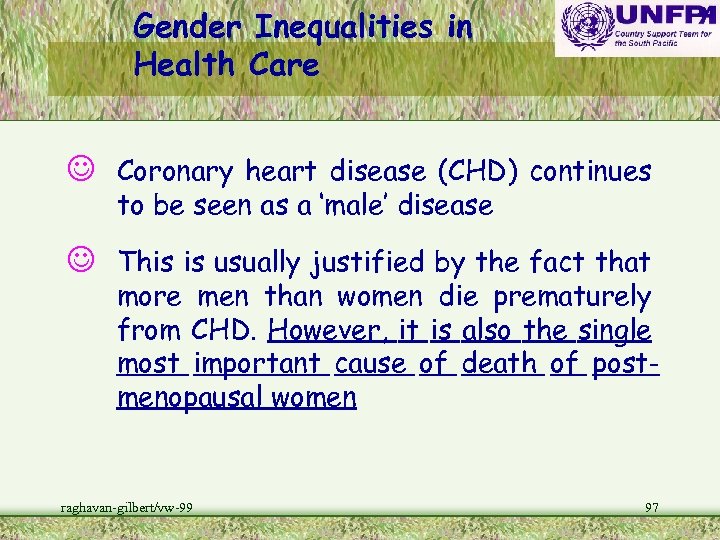
Gender Inequalities in Health Care J Coronary heart disease (CHD) continues to be seen as a ‘male’ disease J This is usually justified by the fact that more men than women die prematurely from CHD. However, it is also the single most important cause of death of postmenopausal women raghavan-gilbert/vw-99 97
![Gender Inequalities in Health Care ] not enough is known about their implications ] Gender Inequalities in Health Care ] not enough is known about their implications ]](https://present5.com/presentation/7bf71a84e81892a5e202d29c8d0a28bd/image-98.jpg)
Gender Inequalities in Health Care ] not enough is known about their implications ] ] to ensure gender sensitivity either in clinical treatment or in strategies for prevention cyclical hormonal changes make the results difficult to interpret female subjects may become pregnant and put the resulting foetus at risk during trials raghavan-gilbert/vw-99 98

Gender Inequalities in Health Care X women continue to be treated on the basis of information gathered from research in which drugs may not have been tested on female bodies, in which the precise manifestation of the disease in women may not have been studied raghavan-gilbert/vw-99 99

Gender Inequalities in Health Care m Women’s experiences of both illness and treatment may not have been adequately explored They are not in themselves arguments for the exclusion of women raghavan-gilbert/vw-99 100
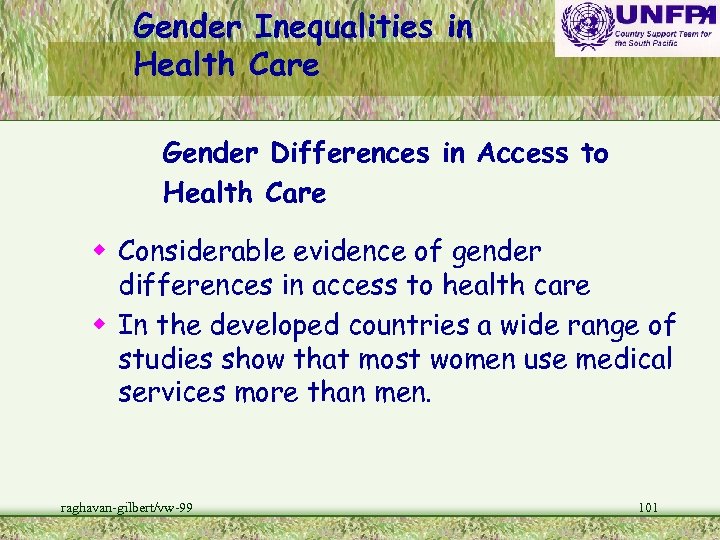
Gender Inequalities in Health Care Gender Differences in Access to Health Care w Considerable evidence of gender differences in access to health care w In the developed countries a wide range of studies show that most women use medical services more than men. raghavan-gilbert/vw-99 101

Gender Inequalities in Health Care _ women in many developing countries are denied these benefits. _ Feminist writers argue that the normal processes of pregnancy and childbearing for instance have been turned into medical events. raghavan-gilbert/vw-99 102

Gender Inequalities in Health Care k k Doctors treat depressed women with a pill rather than identifying underlying causes such as domestic violence or examining their living and working conditions the most pressing concern is not too much medical attention for those who can afford it but lack of attention for those who are poor raghavan-gilbert/vw-99 103

Gender Inequalities in Health Care J Severe constraints on public sector spending obviously affect both sexes J in conditions of poverty it is usually women who face the greatest problems in acquiring adequate health care raghavan-gilbert/vw-99 104

Gender Inequalities in Health Care u less is spent on health care for women and girls in certain regions of the world this reflects both their lower social status and their lack of decision-making power. raghavan-gilbert/vw-99 105

Gender Inequalities in Health Care F F Inequities: Reinforced in settings where customs and values deny women the right to travel alone or to be in the company of men outside their immediate family. Where female health workers are not available treatment by a man may dishonour a woman and her family raghavan-gilbert/vw-99 106

Gender Inequalities in Health Care X Low self esteem limits women’s ability to make demands X Embarrassment if the problem is one that the community disapproves of. X Lack of education contributes to this lack of self worth. raghavan-gilbert/vw-99 107

Gender Inequalities in Health Care z Traditionally, women’s health services have focused on their reproductive needs, especially contraception and safe childbearing z Millions of young women and those who are post-menopausal have been denied access to any health care during periods of great need in their lives. raghavan-gilbert/vw-99 108

Gender Inequities in Quality Of Care q Are the health services women receive comparable to that of men or are there inequalities here too? q There are consistent indications that gender divisions can be a causal factor in limiting the quality of care women receive raghavan-gilbert/vw-99 109
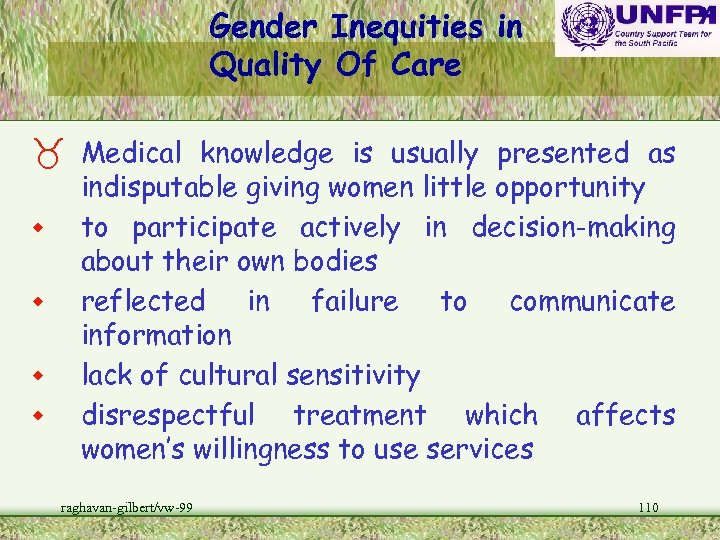
Gender Inequities in Quality Of Care _ Medical knowledge is usually presented as w w indisputable giving women little opportunity to participate actively in decision-making about their own bodies reflected in failure to communicate information lack of cultural sensitivity disrespectful treatment which affects women’s willingness to use services raghavan-gilbert/vw-99 110

Gender Inequities in Quality Of Care p Concern about poor quality services for women focused mostly on the interpersonal relations involved in health care raghavan-gilbert/vw-99 111

Gender Inequalities in Health Care u women and men are sometimes offered different levels of treatment for what appear to be the same clinical conditions raghavan-gilbert/vw-99 112

Gender Inequities in Quality Of Care Y Studies in UK and USA show that women are less likely than men to be offered certain diagnostic procedures on treatments for heart disease. Y Women on kidney dialysis are less likely than men of the transplants. raghavan-gilbert/vw-99 same age to be offered 113

Conclusions n Many ways in which gender influences both health status and health care raghavan-gilbert/vw-99 114

Conclusions j gender j must be placed alongside race and class as a key determinant of health and health care concrete strategies be identified for addressing the health needs of both women and men particularly the planning of services raghavan-gilbert/vw-99 115

Gender Inequalities in Health Care Q ‘Gender blindness’ leading both individuals and organisations to ignore the realities of gender as a key determinant of social inequality raghavan-gilbert/vw-99 116

Gender Inequalities in Health Care r The aim of highlighting gender in this way is to move towards a position of equality r all policies must be designed to promote equality between women and among women themselves. raghavan-gilbert/vw-99 117

Conclusions v v An important distinction has been made between ‘practical needs’ and ‘strategic interests’. Women’s practical needs are usually derived directly from their existing gender roles. These reflect their responsibility for the well-being of their families e. g. easy access to clean water and a regular source of income raghavan-gilbert/vw-99 118

Conclusions Z Most health or development initiatives are designed to meet practical needs of this kind are often greatly valued, by the community as a result. raghavan-gilbert/vw-99 119
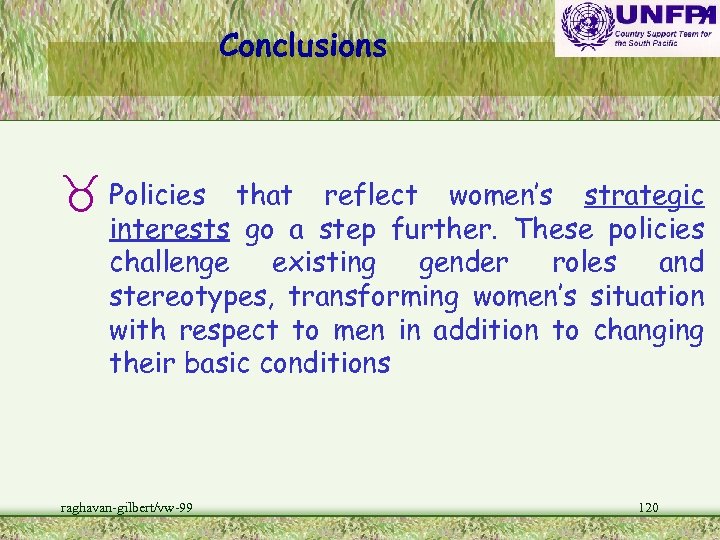
Conclusions _ Policies that reflect women’s strategic interests go a step further. These policies challenge existing gender roles and stereotypes, transforming women’s situation with respect to men in addition to changing their basic conditions raghavan-gilbert/vw-99 120

Conclusions b b w A reproductive health service that simply gave women the technical means to control their fertility would meet their practical needs In order to meet their strategic needs the service would also need to: enable women to choose between a range of contraceptive methods raghavan-gilbert/vw-99 121

Conclusions w w identify the various strategies needed to promote their own well-being encourage men to take responsibility raghavan-gilbert/vw-99 122

Identifying Gender Concerns in the Policy Environment X If the goal of developing gender-sensitive policies and programmes is to be achieved, this needs to be built explicitly into the original objectives raghavan-gilbert/vw-99 123

Identifying Gender Concerns in the Policy Environment K This will require a preliminary analysis of the context in which the policy will be operating and a clear understanding of the gender issues involved. raghavan-gilbert/vw-99 124

Gender Inequalities in Health Care-Research Interests _Do differences in the division of labour expose women and men to different kinds of health risks? _How are any differences between women and men in the use of existing services explained? _Are there apparent differences in the way women and men are treated or in the quality of care they receive? _Who controls access to health-related resources? _Do the criteria for allocation take into account the different roles and needs of women and men? raghavan-gilbert/vw-99 125

Gender Inequalities Health Sector Reform w In most developing countries where health sector reform is being implemented, issues related to financing, resource allocation and management are of the utmost importance raghavan-gilbert/vw-99 126

Gender Inequalities in Health Sector Reform O of particular concern has been the implications of cost recovery for the poor O this concern has not been extended to other dimensions of vulnerability such as gender raghavan-gilbert/vw-99 127
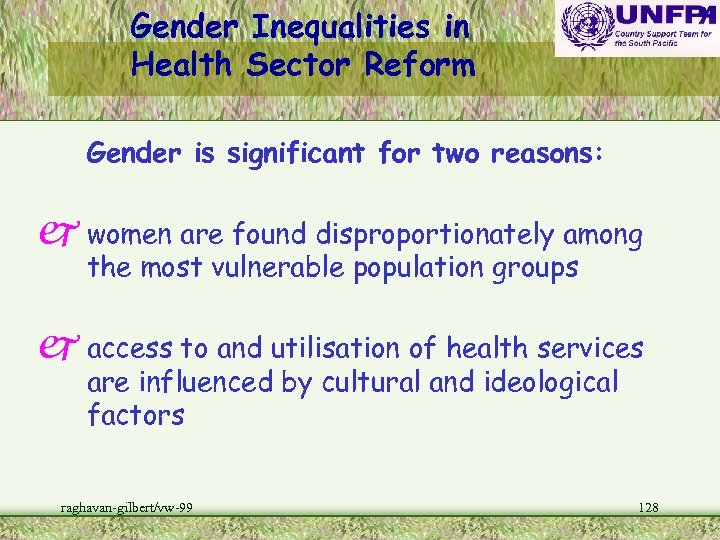
Gender Inequalities in Health Sector Reform Gender is significant for two reasons: j women are found disproportionately among the most vulnerable population groups j access to and utilisation of health services are influenced by cultural and ideological factors raghavan-gilbert/vw-99 128

Gender Inequalities In Health Sector Reform z The types of gender issues requiring attention is related to the six main components of health sector reform programmes. raghavan-gilbert/vw-99 129

Gender Issues in Health Sector Reform ¶ Improving the performance of the civil service (i. e. reducing staff, changing pay, appraisal systems). What would the impact on the gender balance and composition of staffing at different levels be? What effects would human resource policies have on relations between predominantly male health service professions, such as doctors, and those of predominantly females, such as nursing? raghavan-gilbert/vw-99 130
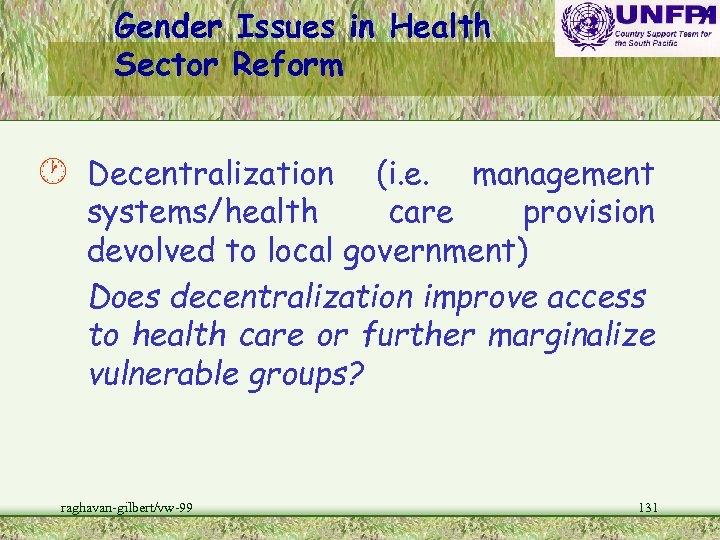
Gender Issues in Health Sector Reform · Decentralization (i. e. management systems/health care provision devolved to local government) Does decentralization improve access to health care or further marginalize vulnerable groups? raghavan-gilbert/vw-99 131

Gender Issues in Health Sector Reform ¸ Improving the functioning of national ministries of health (i. e. human and financial performance monitoring, prioritising and defining cost-effective interventions). What effects would human resources policies have as described in no. 1. In setting priorities, what criteria are used to determine health needs and cost-effectiveness? raghavan-gilbert/vw-99 132

Gender Issues in Health Sector Reform ¹ Broadening health financing options (i. e. introduction of user fees and community financing mechanisms). What are the implications of different modes of payment? Are poor women affected differently than poor men? How does cost recovery affect access to services for both sexes? raghavan-gilbert/vw-99 133

Gender Issues in Health Sector Reform º Introduced managed competition (i. e. establishing mechanisms for regulation, contracting with, or franchising providers in the private sector). How does managed competition affect equity and access for the most vulnerable? raghavan-gilbert/vw-99 134

Gender Issues in Health Sector Reform » Working with the private sector (i. e. establishing mechanisms for regulation, contracting, or franchising providers in the private sector). Are vulnerable groups more or less likely to be appropriately served by different parts of the private sector? Are women’s health needs more or less likely to be met in a mixed economy of health care? raghavan-gilbert/vw-99 135

For example, examining the effects of decentralization - it is likely to have an adverse affect for women if steps are not taken to develop measures of equity in resource allocation and systems to measure social vulnerability because w of inter-regional inequalities w wealthier areas would be able to lure good staff w this is likely to hit women harder raghavan-gilbert/vw-99 136

Z Reforms are clearly having a major Z impact on women both as users of services and as health workers If gender inequities in health are to be clearly identified, women themselves will need to be involved raghavan-gilbert/vw-99 137

Planning, Capacity Building, Monitoring and Evaluation w Special care has to be taken to ensure their views are heard. w discussion with the appropriate interest groups w direct consultation with potential users w a diversity of views is represented raghavan-gilbert/vw-99 138

Planning, Capacity Building, Monitoring and Evaluation n capacity-building programmes must be designed for both female and male workers n need to focus not just on ‘women’s issues’ but on the wider question of gender raghavan-gilbert/vw-99 139
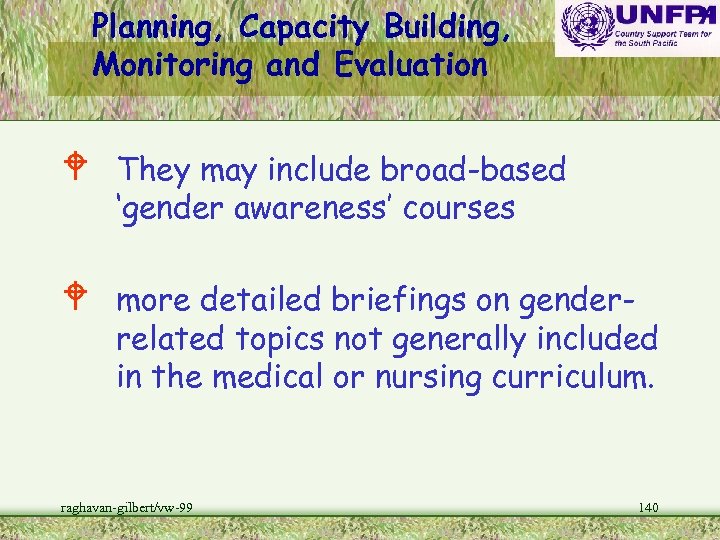
Planning, Capacity Building, Monitoring and Evaluation W They may include broad-based ‘gender awareness’ courses W more detailed briefings on genderrelated topics not generally included in the medical or nursing curriculum. raghavan-gilbert/vw-99 140

j All policies and programmes require a clear strategy for monitoring and evaluation j Criteria for achieving this will need to be carefully constructed into and built into the planning process of the specific programme from the earliest stages raghavan-gilbert/vw-99 141

j Clearly identify the effects of the project or programme on women and men j directly measure how a project or programme is effective for sexes j take the necessary management decisions. raghavan-gilbert/vw-99 142

Key References: Gender in RH l l l WHO Technical Paper WHO/FRH/WHD/98/16, Gender and Health The Battered Woman, Lenore Walker, 1979 Row & Harper NY. ARROW: 1997 Gender and Women’s Health Information Package No. 2 Kuala Lumpur Malaysia raghavan-gilbert/vw-99 143
7bf71a84e81892a5e202d29c8d0a28bd.ppt